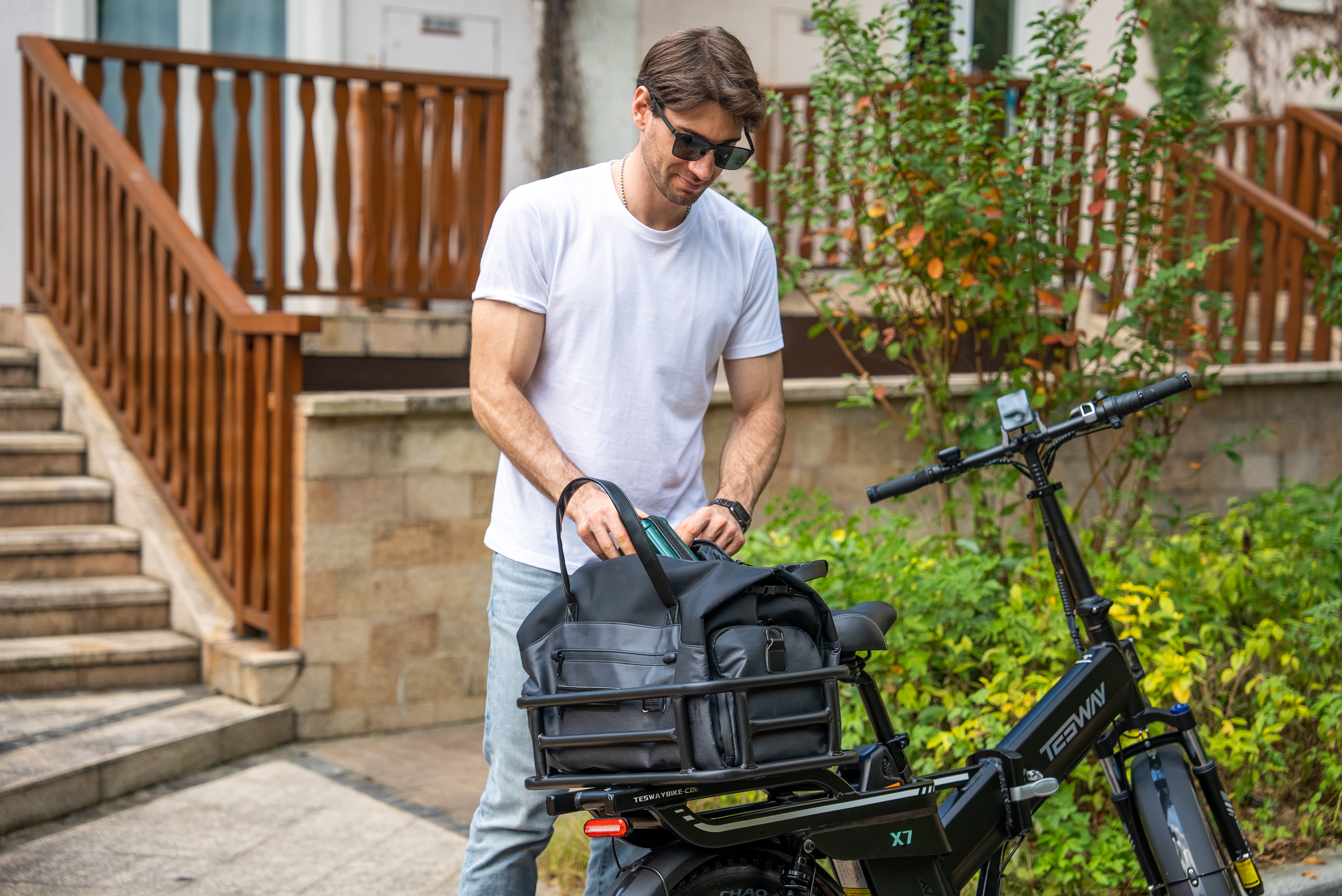Electric bikes have revolutionized the way we travel, offering greater range and ease of use. They are not only reliable and affordable but also promote greener living, enhancing our health and the environment. E-bikes are versatile, allowing riders to navigate city centers or embark on longer journeys with ease. Companies such as Brose, Bafang, Bosch, and Mano are at the forefront of developing high-performance e-bike motor drives.
Connection Method of Electric Bicycle
Electric bicycles use different methods to connect their components, significantly impacting their performance and user experience. The most popular configuration is the parallel connection, where human torque and motor torque combine mechanically through gears. This setup ensures efficient power transmission, leveraging both human and motor inputs to drive the bike.
In contrast, series vehicles lack mechanical transmission. Instead, the pedals connect to a generator that is electrically coupled to the battery pack and the motor. This double conversion of human power allows for optimal cadence on all slopes, mimicking the efficiency of hybrid machines by maintaining the motor at its peak performance point. This method provides high efficiency, as it keeps the driver consistently at their optimal efficiency point.
In a parallel configuration, mechanical gears facilitate the combination of human and motor torque, enhancing power output and control. On the other hand, the series configuration eliminates direct mechanical links, relying entirely on electrical connections to optimize energy use and performance.
Types of Motors Currently Used on Ebikes
The motor is a critical component that significantly affects performance. Currently, the market features several types of motors, each with distinct characteristics and working principles.
Hub Motors
Hub motors are widely used in e-bikes due to their simplicity and effectiveness. These motors are integrated into the hub of either the front or rear wheel, directly driving the wheel without the need for chains or gears. The hub motor's working principle is straightforward: it uses a series of magnets and coils to generate rotational force, propelling the wheel forward.
There are two main types of hub motors: geared and gearless (direct drive). Geared hub motors contain internal gears that increase torque, making them suitable for hilly terrains and heavy loads. However, they produce more noise and have more moving parts, which can lead to increased maintenance. On the other hand, gearless hub motors operate silently and are virtually maintenance-free but tend to be heavier and less efficient at lower speeds.
Mid-Drive Motors
Mid-drive motors are another popular type, known for their balance and power. Positioned at the bike's crank, these motors drive the bike's chain, benefiting from the bike's gear system to optimize performance. This placement offers several advantages, including better weight distribution and enhanced torque for climbing steep hills.
The working principle of mid-drive motors involves a compact motor driving the crankshaft, which in turn drives the bike's chain and gears. This setup allows the motor to work efficiently across a range of speeds and terrains, providing a more natural riding experience.
Friction Drive Motors
Friction drive motors are less common but still in use. These motors generate power through friction between the motor and the bike's tire, propelling the bike forward. While simple and easy to install, friction drive motors can be less efficient and more prone to wear and tear compared to hub and mid-drive motors.
In addition to these standard motor types, advanced technologies are emerging in the e-bike market.
For instance, Brose motors are known for their high torque and smooth, quiet operation, while Bafang motors are praised for their versatility and power. Bosch motors offer a range of features, including sophisticated torque sensors and intelligent battery management systems, ensuring a seamless and efficient riding experience.
Comparison Between Mid-Mounted Motor and Hub Motor
Choosing between a mid-mounted motor and a hub motor can be challenging, as both have distinct advantages and disadvantages.
Mid-Mounted Motor
Mid-mounted motors are lauded for their balance and power efficiency. Positioned centrally at the bike's crankshaft, they contribute to a lower center of gravity, enhancing the bike's stability and handling. This motor type drives the bike's chain directly, utilizing the bike's existing gear system to optimize performance across various terrains.
The advantages of mid-mounted motors include:
- Efficient Power Transfer: By driving the bike's chain, mid-mounted motors benefit from the bike's gears, allowing for optimal power usage and better performance on hills.
- Improved Handling: The central placement of the motor ensures a balanced weight distribution, enhancing the bike's stability and control.
- Higher Torque: These motors provide excellent torque, making them ideal for climbing steep hills and carrying heavy loads.
However, there are some drawbacks to consider:
- Increased Wear and Tear: Since mid-mounted motors drive the bike's chain, they can cause more wear on the chain and gears, requiring more frequent maintenance.
- Complex Installation: Installing mid-mounted motors can be more complex compared to hub motors, often requiring professional assistance.
Hub Motor
Hub motors, on the other hand, are known for their simplicity and ease of use. These motors are integrated into the hub of either the front or rear wheel, directly driving the wheel without the need for chains or gears.
The advantages of hub motors include:
- Simple Installation: Hub motors are generally easier to install and require less maintenance compared to mid-mounted motors.
- Quiet Operation: Gearless hub motors operate silently, providing a smoother and quieter ride.
- Less Wear on Components: Since hub motors do not drive the bike's chain, they cause less wear and tear on the bike's drivetrain components.
However, hub motors also have some disadvantages:
- Limited Torque: Hub motors, especially gearless ones, typically offer less torque compared to mid-mounted motors, making them less suitable for steep hills and heavy loads.
- Weight Distribution: Hub motors can make the bike feel less balanced, particularly if the motor is on the front wheel, affecting the bike's handling.
Mid-mounted motors excel in situations that demand high torque and efficient power transfer, such as hilly terrains and off-road adventures. They provide a more natural riding experience, leveraging the bike's gear system to maintain optimal performance. However, they require more maintenance due to the increased strain on the bike's chain and gears.
Hub motors, conversely, are ideal for riders seeking simplicity and low maintenance. Their direct drive mechanism reduces the need for frequent upkeep, making them suitable for urban commuting and flat terrains.
The silent operation of gearless hub motors also enhances the riding experience, offering a smooth and quiet journey. However, their limited torque and potential impact on weight distribution can be a drawback for those needing more power and balance.
Which motor is better? Actually, there is no a clearified answer. the choice between a mid-mounted motor and a hub motor hinges on your riding preferences and requirements. For power and performance, especially in challenging terrains, a mid-mounted motor is the superior choice. For ease of use and maintenance, particularly in urban environments, a hub motor may be more suitable.
Best Value for Money
Considering an e-bike with a high-powered mid-mounted motor might seem appealing, but their high price can be a significant drawback. Ask yourself: "If I can't fully use all the advanced features, am I wasting my money?" For most people, a hub motor more than meets their needs and often exceeds expectations.
Take Jackson, for example. He bought the TESWAY X5, a folding elctric bicyle with fat tire, and couldn't be happier. "I have never loved this bike so much. I use the X5 for all my travel needs," he says. The TESWAY X5 is packed with impressive features that make it a top choice for anyone seeking a reliable and affordable e-bike.
With a top speed of 28 mph, 70Nm motor torque, a maximum load of 350 pounds, level 5 pedal assist, and the ability to travel up to 90 miles on a single charge, the X5 offers incredible value.
If you want to get the most out of your money, just consider the TESWAY X5. It provides a great balance of performance, reliability, and affordability. With the TESWAY X5, you're not just getting a bike—you're investing in a smarter, more cost-effective way to travel.
FAQs
What is the difference between a mid-drive motor and a hub motor?
Mid-drive motors are positioned at the bike's crankshaft and drive the chain, offering better torque and efficiency. Hub motors are located in the wheel hub and drive the wheel directly, providing simpler installation and less maintenance.
Are mid-drive motors better for hills?
A: Yes, mid-drive motors excel in hilly terrains due to their higher torque and ability to utilize the bike's gears for optimal power transfer.
Do hub motors require a lot of maintenance?
A: No, hub motors generally require less maintenance than mid-drive motors since they do not put extra strain on the bike's chain and gears.












Share:
Is a Fat Tire eBike Your Best Bet? A Physics Analysis
Different Types Of Ebike | Which one you should buy?